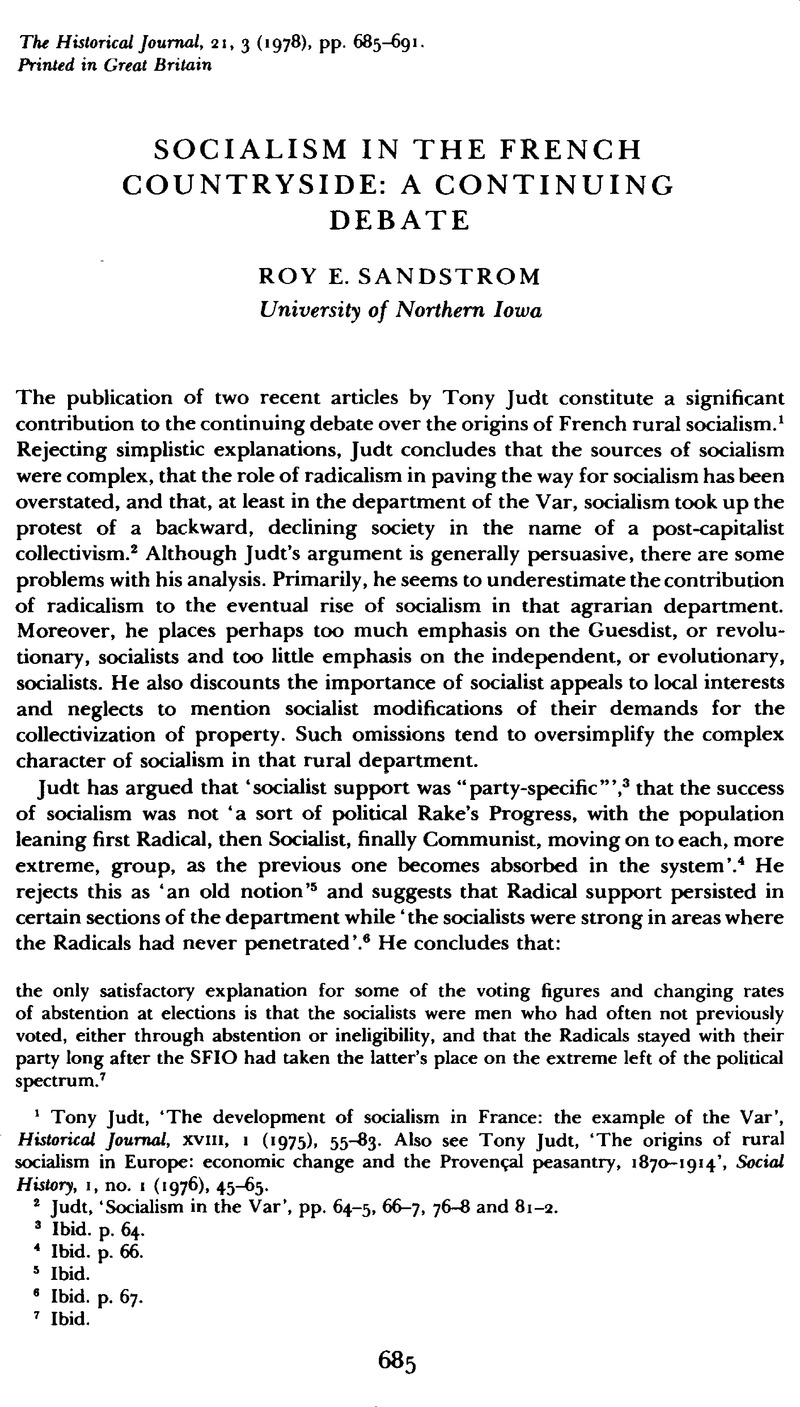No CrossRef data available.
Published online by Cambridge University Press: 11 February 2009

1 Judt, Tony, ‘The development of socialism in France: the example of the var’, Historical Journal, XVIII, 1 (1975), 55–83.CrossRefGoogle Scholar Also see Judt, Tony, ‘The origins of rural socialism in Europe: economic change and the Provençal peasantry, 1870–1914’, Social History, 1, no. 1 (1976), 45–65.CrossRefGoogle Scholar
2 Judt, , ‘Socialism in the Var’, pp. 64–5, 66–7, 76–8 and 81–2.Google Scholar
3 Ibid. p. 64.
4 Ibid. p. 66.
5 Ibid.
6 Ibid. p. 67.
7 Ibid.
8 Loubère, Leo A., Radicalism in Mediterranean France, 1848–1914 (Albany, N.Y., 1974), p. 205.Google Scholar
9 Willard, Claude, Le mouvement socialiste en France (1893–1905): les Guesdistes, (Paris, Editions Sociales, 1965), p. 285.Google Scholar
10 Judt, , ‘Socialism in the Var’, pp. 66–7.Google Scholar
11 Ibid. p. 66.
12 Ibid. p. 62.
13 The following table indicates Radical strength from 1885–1898:

14 The system of scrutin de liste was used in that year. Such a system tends to emphasize party rather than personality. Led by Georges Clemenceau, the Radical list of 1885 seems to have inherited the moderate vote on the second ballot. See Loubère, , p. 118 for a discussion of that election.Google Scholar
15 Le Petit Var, 6 10 1885.Google Scholar
16 Judt, , ‘Socialism in the Var’, p. 62.Google Scholar
17 In 1889 the Radicals received 73% of the votes cast. In 1893, they received 65% of the votes on the second ballot. This is strikingly similar to the 66% for Rousse in 1898.
18 The election results for Rousse in 1898 allow us to test the hypothesis that there is a statistically significant correlation between radicalism, radical-socialism, and socialism in that arrondissement.
19 Correlations are based on percentage of the registered voters unless otherwise indicated. All correlations are Pearson-Product-moment. In almost every case, Spearmanrho correlations are slightly higher than those for the Pearson-Product-moment coefficients.
20 Although the number of communes for which we have complete data varies by election, the lowest total for the entire department is 123 and the highest is 132 (out of a possible 144). Data was obtained from Le Petit Var of 6 10 1885 and 22 05, 1898.Google Scholar
21 Data for 1914 was obtained from Le Petit Var of 26 April of that year.
22 In many studies of political behaviour, a confidence level of 0·05 is specified. Thus, these results are within that range.
23 This is based on the ballots cast. The correlation between radical-socialism in 1898 and socialism in 1914 for the arrondissement of Brignoles is only +0·1872 for 46 communes which is significant only at the 0·106 level, when measured as a percentage of the registered voters. It may be a mistake, however, to place too much emphasis on this latter correlation since, by 1914, the socialists received over 90% of the vote in that arrondissement. The failure of the conservatives to mount a serious threat in 1910 may have significantly altered the inclination of many socialists to vote by 1914. In that case, the percentage of popular vote obtained by the socialists may be a more reliable index of local support than the percentage of the registered voters which is usually regarded as the more stable of the two indices.
24 There is also a positive and statistically significant correlation between Radicalism in 1885 and socialism in 1914 for the arrondissement of Brignoles (r = + 0·3577, N = 46, S = 0·007) which is consistent with these results.
25 Judt, , ‘Socialism in the Var’, p. 67.Google Scholar
26 Judt, Tony, ‘Socialism in the Var’, p. 76Google Scholar and, especially, ‘Rural socialism in Europe’, P. 59.Google Scholar
27 Willard, , Le mouvement socialiste, p. 285.Google Scholar
28 Judt, , ‘Socialism in the Var’, p. 69.Google Scholar For a diametrically opposed view see Loubère, Radicalism in France, p. 205.Google Scholar
29 Compère-Morel, , La Question agraire et le socialisme en France (Paris, 1912), p. 117.Google Scholar
30 Ibid. Italics are from Compère-Morel's text.
31 Ibid. pp. 47 and 115.
32 Ibid. pp. 117–18.
33 Ibid. p. 120.
34 Goldberg, Harvey, The life of Jean Jaurès (Madison, Wisconsin, 1962), p. 185.Google Scholar
35 Tabouriech, Ernest, ‘Mouvement agraire: le propagande agraire du Parti Socialiste’, Revue Socialiste, 03, 1910, pp. 252–4.Google Scholar
36 Le Cri du Var, 11 06, 1910.Google Scholar
37 Le Petit Var, 30 04, 1906.Google Scholar
38 Judt, , ‘Socialism in the Var’, p. 78.Google Scholar
39 See Le Petit Var for 03 and 04 1910Google Scholar, especially for 24 April. Loubère argues that ‘These same socialists proudly announced to their electors that they supported bills to suppress fraud, to encourage distilling of wine to lessen the supply, to build irrigation canals to help small owners diversify crops, and to implement the rest of the old Radical program’ (p. 205).
40 This point is developed quite extensively in Warner, Charles K., The wine-growers and the government of France since 1875 (New York, 1960).Google Scholar A more recent version of the argument was presented in a paper read by J. Harvey Smith, ‘The crisis of a regional economy: winegrowing monoculture and the revolt of the Midi (1907)’, at the Pacific Coast Branch meeting of the American Historical Association, La Jolla, California, 18 August 1976.
41 Judt, , ‘Socialism in the Var’, p. 69.Google Scholar
42 Loubère, , Radicalism in France, pp. 1–3.Google Scholar
43 See Sandstrom, Roy E., A social and political history of the Var, 1871–1914, unpublished dissertation, Buffalo, New York, State University of New York, 1972, pp. 139 ff.Google Scholar